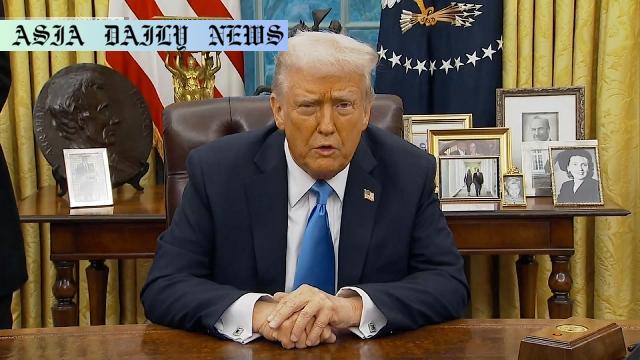Middle East: US President Donald Trump plans a potential visit to Saudi Arabia and other Middle East nations to enhance ties and discuss global issues.
Trump plans a Middle East visit, potentially starting with Saudi Arabia, symbolizing the first foreign trip of his second term.
The agenda includes strengthening economic ties, ceasefire discussions for Ukraine and Russia, and mediating Israel-Hamas tensions.
Stops may include major nations like Qatar and the UAE, with Saudi Arabia likely hosting potential summits with global leaders.

Trump’s Strategic Visit to the Middle East
US President Donald Trump has announced plans for an upcoming visit to the Middle East, with Saudi Arabia as a probable focal point. This move could mark his first overseas diplomatic maneuver in a potential second term, signaling his administration’s continued emphasis on fostering relationships in the region. Known for his strong ties with Saudi Crown Prince Mohammed bin Salman, Trump mentioned these relationships as a foundation for addressing various geopolitical issues.
During his announcement on Monday, Trump emphasized the strategic importance of the Middle East for the United States, citing economic cooperation and regional stability as primary objectives. This trip, expected to take place as early as May, will likely serve as an opportunity to strengthen economic and diplomatic partnerships. Trump’s previous trips in his first term also heavily focused on the Middle East, underscoring consistent efforts to build bilateral ties with countries in the region, particularly Saudi Arabia.
Partners in Addressing Global Issues
One of the key objectives of Trump’s upcoming visit will be facilitating discussions about mitigating ongoing global crises. The President expressed his desire to urge Saudi Arabia and other allied nations to help mediate a ceasefire between Russia and Ukraine. Such positioning demonstrates an attempt to align Middle Eastern geopolitical influence with US-led diplomatic goals.
Additionally, Trump may engage in efforts to reignite peace talks between Israel and Hamas, which have stalled amidst ongoing tensions. By involving Saudi Arabia and other key regional players, he seeks to leverage their influence in maintaining and promoting peace within the region. His approach resonates with previous diplomatic efforts and reinforces the Middle East’s critical role as a conduit for broader stability.
Economic Partnerships and Bilateral Talks
Beyond political discussions, strengthening economic partnerships will feature prominently on Trump’s agenda. His administration has frequently underscored the importance of collaboration in sectors such as energy, technology, and security, viewing Saudi Arabia as a vital partner in these pursuits. The President’s visit will likely highlight ongoing US-Saudi economic initiatives while exploring new avenues for cooperation with Qatar and the UAE.
Trump’s focus on the Middle East underscores broader ambitions to balance economic growth with security objectives, ensuring the region remains a critical ally for the United States. Such interactions emphasize the interplay of economic and military partnerships that have defined US-Middle East relations.
Middle East as a Diplomatic Hub
The possibility of hosting a summit with Russian President Vladimir Putin in Saudi Arabia further illustrates Trump’s vision of transforming the Middle East into a diplomatic hub. Positioning Saudi Arabia as a central platform for resolving international conflicts affirms the region’s growing role in global politics. These discussions could pave the way for long-term strategies that align regional and international ambitions under the banner of mutual cooperation.
As Trump prepares for this landmark visit, his administration’s focus remains clearly on leveraging enduring relationships in the Middle East to tackle critical challenges on the global stage. The visit may symbolize a new chapter in US diplomacy, one aimed at fostering unity and progress across economic, political, and security dimensions.



Commentary
The Significance of Trump’s Middle East Visit
President Trump’s decision to prioritize the Middle East in his foreign visits reflects the immense strategic importance of the region to US interests. The Middle East has long been a focal point for global politics and diplomacy, and America’s continued engagement signifies its commitment to fostering both stability and progress. By targeting Saudi Arabia as the primary destination, Trump emphasizes the importance of this long-standing ally as a cornerstone of regional security and economic partnerships.
What stands out in Trump’s planned visit is the multifaceted nature of its objectives. While previous administrations have often focused on singular policy angles, Trump appears intent on tackling a wide range of issues—from economic collaboration to conflict resolution and peacebuilding. This approach reflects an understanding of the interconnected nature of challenges faced by the region. By deeply engaging with key nations such as Saudi Arabia, Qatar, and the UAE, the administration looks to strengthen alliances that transcend traditional boundaries.
Potential Impact on Global Diplomacy
Of particular interest is Trump’s call for Saudi Arabia to play an active role in mediating between Russia and Ukraine. By involving the Middle East in such a high-stakes international conflict, the President seeks to elevate the region’s role as a mediator on the global stage. This may set an important precedent for leveraging Middle Eastern influence in future crises.
Moreover, the potential summit with Vladimir Putin in Saudi Arabia further underscores the ambitious diplomatic aspirations of this visit. If successful, such discussions could yield meaningful progress—not only in easing tensions between involved nations but also in reaffirming the Middle East’s position as a bridge between contentious global powers.
A Pivotal Moment for Middle East Relations
Ultimately, Trump’s planned trip to the Middle East presents a high-stakes opportunity. It offers a platform to address urgent concerns like the Israel-Hamas conflict while also solidifying long-term economic and political ties that benefit all parties involved. If executed effectively, this visit could enhance the United States’ stature as a key player in facilitating regional and global stability.
The coming weeks will reveal how these plans materialize, but one thing remains clear: Trump’s Middle East strategy signals a shift toward more dynamic and interconnected diplomacy, emphasizing the intertwined nature of economic, political, and security priorities in shaping a resilient future for the region.